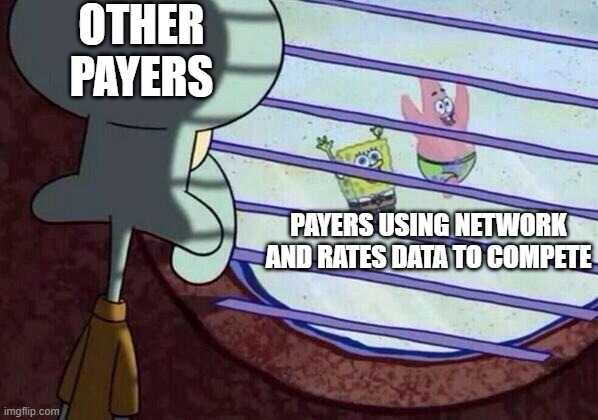Regulatory Requirements on Network and Price Transparency
Transparency-related federal rules are causing a seismic shift in the healthcare industry, compelling payers to reconsider their competitive strategies. The age-old practice of guarding provider networks and negotiated rates in secrecy is being challenged by government rules requiring this information to be published. As the Transparency in Coverage Rule and the provider directory provisions of the Interoperability and Patient Access Rule are implemented, payers are realizing that industry stakeholders and regulators are increasingly scrutinizing and using this data. The trajectory is clear: the health care industry is moving towards more transparency, and payers must be prepared to not just comply, but learn how to compete differently.
How is Industry using Newly Available Network and Price Data?
Historically, health insurers kept information about provider networks and contracted rates secret. Keeping network and rate information proprietary created barriers for would-be competitive payers, gave payers an advantage in contracting with providers, and altogether preserved positions of market power for incumbents by ensuring information asymmetry. As the curtains are pulled back on payers’ provider networks and contracted rates, industry players are exploring how to use the data to challenge the status quo.
Providers can use this data to more aggressively negotiate contracts with payers (by citing higher rates payers are paying other providers and/or knowing network gaps they can fill). Other payers can use the information to see how their networks compare with competitive networks, and use the information to expand into new markets. Employers are using this information to hold TPAs accountable for payments, and are contracting with payers who will provide access to their claims data to support accountability. Patients are using this data as well, through third-parties who are presenting Insurance and Price information in consumer-friendly workflows.
A Clear Decision: Obfuscate the Data or Embrace Transparency?
Some payers view these changes as threats to their traditional way of doing business, and choose to either obfuscate data, or under-resource the technical teams responsible to achieve the same effect. Payer execs might be thinking, ‘Being more transparent doesn’t help me, so why should I rush it?’ or ‘Let everybody else be transparent first, and then I’ll get to it’. This is a risky path for payers to take, as the public nature of these data sets makes it quickly obvious whether payers are complying and doing so comprehensively.
Hundreds of third-party developers, provider organizations, other payers, regulators, and advocacy groups are scrutinizing these data daily, and sharing notes among each other (even among competitors). There are public Slack, Discord, and GitHub forums where tech-savvy individuals and organizations who have the skills and technology to review and analyze the terabytes of data, are asking the hard questions. It is better to invest now to comply with these rules, so as to avoid redundant technology spend (and unnecessary re-platforming) and so that payers can instead focus their future attentions on how to compete in a transparent industry.
How Payers Can Compete in a Transparent Industry
There are myriad ways payers can compete, taking advantage of newly available network and rate transparency data, and offering differentiated services to members and providers. What follows are some examples of how payers are already thinking about competing differently in a transparent industry.
Use the Data: There is a wealth of value for payers in the newly available Provider Directory APIs and Price Transparency Machine-Readable Files. Payers should put it to use in multiple ways.
Payers can use other payers’ network data from Directory APIs to:
- Compare their networks against their competitors in terms of providers
- Help cleanse their directory for errors
- Find new providers to recruit
The Price Transparency MRFs can also help payers:
- Understand where their rates stand in the range of prices paid to providers
- Assist with contract negotiations, and
- Help converge on and justify ‘standard’ pricing to new providers they are trying to enroll.
Differentiate Your Plans to Members: With transparency, and as networks become commoditized, it will be important for payers to differentiate plan offerings beyond the size and geographic coverage of the network.
Payers will need to show how their network can:
- Meet the needs of diverse member populations
- Offer interventions to address social determinants of health
- Demonstrate the availability of virtual care modalities, and
- Offer next-generation provider referral capabilities.
This will require payers to meet members where they want to interact (i.e., not on the payers’ portal or app). Members may want to interact with payers and their data via third-party tools, which will require more developer-friendly experiences than most payers have historically offered to the developer community.
Differentiate Your Network to Providers: As the provider workforce supply tightens (due to retirement or burn-out), and as contracted rates converge, payers will have to compete differently to get providers into network. This will require that payers make it as easy as possible for providers to enroll and remain in network.
Payers should seek opportunities to accelerate their provider enrollment process:
- Automating and accelerating enrollment
- Streamlining credentialing applications,
- Offering standard rates and even ‘one click enrollment’
- Payers could entice high quality providers to join by offering higher than average rates. This will become possible as digital quality measures enable complete and real-time quality data.
Summary and Conclusion
With regulatory requirements and observed industry use of transparency data, it is inevitable that healthcare will become more transparent over time. Payers should be aware that various parts of the industry are scrutinizing their data for availability and completeness, and they should comply to avoid penalties and other enforcement actions.
Payers should focus instead on how they will use network and rate transparency data, and decide how they want to compete. This could involve, as examples, creating differentiated plan offerings for members, or more efficient onboarding for providers. Regardless, they should realize that keeping network and rate information secret is no longer a sustainable way to compete in an industry that is embracing provider network transparency.
